Monthly Archives: May 2021
 Through the years, Russia, also known as the Soviet Union and the USSR, has been sometimes ally and sometimes enemy of the United States. World War I and World War II found the Soviet Union once again on the side of good as a part of the Allied Forces. The main countries in the Allied powers of World War I were France, the British Empire and the Russian Empire. The main Allied powers of World War II were France, Great Britain, the United States, China, and the Soviet Union. So in these two wars anyway, the United States and Russia were on the same side. The three principal partners in the Axis alliance in World War II were Germany, Italy, and Japan. They were joined by Bulgaria, Hungary, Romania and Thailand, who also signed the Tri-Partite Pact as member states.
Through the years, Russia, also known as the Soviet Union and the USSR, has been sometimes ally and sometimes enemy of the United States. World War I and World War II found the Soviet Union once again on the side of good as a part of the Allied Forces. The main countries in the Allied powers of World War I were France, the British Empire and the Russian Empire. The main Allied powers of World War II were France, Great Britain, the United States, China, and the Soviet Union. So in these two wars anyway, the United States and Russia were on the same side. The three principal partners in the Axis alliance in World War II were Germany, Italy, and Japan. They were joined by Bulgaria, Hungary, Romania and Thailand, who also signed the Tri-Partite Pact as member states.
On May 12, 1942, Soviet forces under the command of Marshal Semyon Timoshenko attacked the German 6th 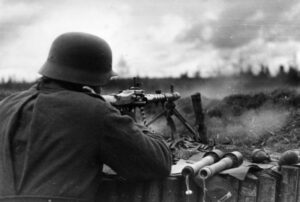 Army from a vulnerable point established during the winter counter-offensive. After a promising start, the offensive was stopped on May 15th by massive airstrikes. There were a number of critical Soviet errors by several staff officers and by Joseph Stalin, who failed to accurately estimate the 6th Army’s potential and overestimated their own newly raised forces, facilitated a German pincer attack on May 17th which cut off three Soviet field armies from the rest of the front by May 22nd. The Soviet Army was hemmed into a narrow area, and the 250,000-strong Soviet force inside the pocket was exterminated from all sides by German armored, artillery, and machine gun firepower, as well as 7,700 tons of air-dropped bombs. After six days of encirclement by the German Army, the Soviet resistance ended as their troops were killed or taken prisoner. It was a devastating loss for the Soviets.
Army from a vulnerable point established during the winter counter-offensive. After a promising start, the offensive was stopped on May 15th by massive airstrikes. There were a number of critical Soviet errors by several staff officers and by Joseph Stalin, who failed to accurately estimate the 6th Army’s potential and overestimated their own newly raised forces, facilitated a German pincer attack on May 17th which cut off three Soviet field armies from the rest of the front by May 22nd. The Soviet Army was hemmed into a narrow area, and the 250,000-strong Soviet force inside the pocket was exterminated from all sides by German armored, artillery, and machine gun firepower, as well as 7,700 tons of air-dropped bombs. After six days of encirclement by the German Army, the Soviet resistance ended as their troops were killed or taken prisoner. It was a devastating loss for the Soviets.
The Counter-offensive of the Second Battle of Kharkov, was called Operation Fredericus, and was launched by the Axis forces in the region around Kharkov against the Red Army Izium bridgehead offensive, and was conducted from May 12 to May 28, 1942, on the Eastern Front during World War II. The objective was to 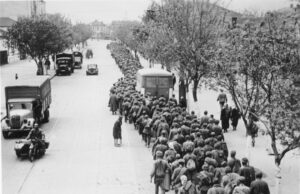 eliminate the Izium bridgehead over Seversky Donets, also known as the “Barvenkovo bulge,” which was one of the Soviet offensive’s staging areas. A winter counter-offensive drove German troops away from Moscow, but depleted the Red Army’s reserves. The Kharkov offensive was next Soviet attempt to expand their strategic initiative, although it failed to secure a significant element of surprise. The battle ended up being an overwhelming German victory, with 280,000 Soviet casualties compared to just 20,000 for the Germans and their allies. The German Army Group South pressed its advantage, encircling the Soviet 28th Army on June 13 in Operation Wilhelm and pushing back the 38th and 9th Armies on June 22.
eliminate the Izium bridgehead over Seversky Donets, also known as the “Barvenkovo bulge,” which was one of the Soviet offensive’s staging areas. A winter counter-offensive drove German troops away from Moscow, but depleted the Red Army’s reserves. The Kharkov offensive was next Soviet attempt to expand their strategic initiative, although it failed to secure a significant element of surprise. The battle ended up being an overwhelming German victory, with 280,000 Soviet casualties compared to just 20,000 for the Germans and their allies. The German Army Group South pressed its advantage, encircling the Soviet 28th Army on June 13 in Operation Wilhelm and pushing back the 38th and 9th Armies on June 22.

 My niece, Andrea Beach is a single mom to her son, Topher Spicer. The two of them are very close, as often happens in these types of circumstances. She is very proud of Topher. Andrea works as a chef at the Turnbuckle Tavern in Rawlins, Wyoming. She has been there for a long time, and they depend on her heavily. Andrea has wanted to be a chef for some time, and in a way, this is a dream come true. Rawlins is a small town, and jobs there are scarce, so the fact that she get to do something she likes is really great.
My niece, Andrea Beach is a single mom to her son, Topher Spicer. The two of them are very close, as often happens in these types of circumstances. She is very proud of Topher. Andrea works as a chef at the Turnbuckle Tavern in Rawlins, Wyoming. She has been there for a long time, and they depend on her heavily. Andrea has wanted to be a chef for some time, and in a way, this is a dream come true. Rawlins is a small town, and jobs there are scarce, so the fact that she get to do something she likes is really great.
Andrea is starting to look forward to summer, like so many others of us. She enjoys going to the Black Hills in South Dakota, a place that is very special to our entire family. It’s not too far from where we all live, and there is lots to do. I don’t think Andrea hikes, like my husband and I do, but that’s the beauty of the Black Hills…something for everybody. There’s lots of shopping and tourist attractions, as well as beautiful drives and scenery.
Andrea also likes to paint. There seem to be a number of artists in our family, but I definitely am not one of them. Andrea seems to have inherited that artistic gene, as have several other members of my family. As for the rest of us…those who are not artistic, we will just have to enjoy the work of the ones who are artistic.
Of course, the most important thing in Andrea’s life will always be her son. Topher has had a number of 
 interests through the years…soccer, drama, and broadcasting. Every child has to try new things before they settle on what they want to do. It takes good parents to allow their child to explore new ideas and phases, being supportive all the way. That is how Andrea is. Topher is able to explore new interests, and Andrea is right there with him. Some day, he will settle on what he wants to do, and she will be right there to support him all the way. That is a good mom. I think she learned from her mom. Today is Andrea’s birthday. Happy birthday Andrea!! Have a good day!! We love you!!
interests through the years…soccer, drama, and broadcasting. Every child has to try new things before they settle on what they want to do. It takes good parents to allow their child to explore new ideas and phases, being supportive all the way. That is how Andrea is. Topher is able to explore new interests, and Andrea is right there with him. Some day, he will settle on what he wants to do, and she will be right there to support him all the way. That is a good mom. I think she learned from her mom. Today is Andrea’s birthday. Happy birthday Andrea!! Have a good day!! We love you!!
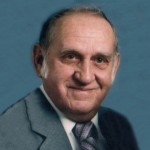
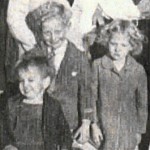 My Uncle Larry Byer was talented in music. He played the guitar, the mandolin, and the piano. My grandfather, his dad, George Byer played the mandolin and the violin. My dad, Al Spencer and my Uncle George both played guitar. They had a regular band, and their jam sessions were like a big party at the Byer house. The kids all had friends who came over as much as they could to listen to the concerts. There were others that joined in sometimes playing the instruments they knew too. It made for a great Saturday night hot spot. Uncle Larry, Grandpa, my dad, and Uncle George are all in Heaven now, and I’ll bet they are all still having those jam sessions, and enjoying the fun times. A Heavenly Band is always in demand.
My Uncle Larry Byer was talented in music. He played the guitar, the mandolin, and the piano. My grandfather, his dad, George Byer played the mandolin and the violin. My dad, Al Spencer and my Uncle George both played guitar. They had a regular band, and their jam sessions were like a big party at the Byer house. The kids all had friends who came over as much as they could to listen to the concerts. There were others that joined in sometimes playing the instruments they knew too. It made for a great Saturday night hot spot. Uncle Larry, Grandpa, my dad, and Uncle George are all in Heaven now, and I’ll bet they are all still having those jam sessions, and enjoying the fun times. A Heavenly Band is always in demand.
Uncle Larry was also a funny guy. He loved a good joke, as well as pulling a few pranks now and then. You never knew what he might do, and that was part of his charm. Together with my mom, Collene Spencer and my Uncle Wayne Byer, there was never a dull moment. What one didn’t think of another did. They were truly like the Three Musketeers!! My grandma, Hattie Byer was often forced to give them an “attitude adjustment” to straighten them out. All in all, they were good kids though…just mischievous.
When he grew up, Uncle Larry served in the United States Army, in the Korean War. While fighting a war would b the pits, my guess is that Uncle Larry took his famous humor with him, and was probably a great asset to the morale of the troops. In fighting a war, it helps to have a little humor. I helps the soldiers to let off steam. War is an ugly event, and sometimes a good laugh is very much needed. In those cases, Uncle Larry would have been the man for the job, in my opinion. Still, Uncle Larry could be serious when it was required of him, and he was a great soldier too. He served his country honorably, and when he was honorably discharged, he came 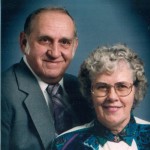
 home and rekindled a friendship with his future wife, Jeanette Morton, who had been a family friend for years. They married on February 11, 1956. Their son Larry Wayne Byer was born a year later on February 9, 1957, and daughter Tina followed on November 12, 1958. Their family was complete…until the grandchildren came along that is. Uncle Larry left us for his Heavenly home on December 22, 2011. Today he would have been 87 years old. Happy birthday in Heaven, Uncle Larry. Strike up the band and have a great party. We love and miss you very much.
home and rekindled a friendship with his future wife, Jeanette Morton, who had been a family friend for years. They married on February 11, 1956. Their son Larry Wayne Byer was born a year later on February 9, 1957, and daughter Tina followed on November 12, 1958. Their family was complete…until the grandchildren came along that is. Uncle Larry left us for his Heavenly home on December 22, 2011. Today he would have been 87 years old. Happy birthday in Heaven, Uncle Larry. Strike up the band and have a great party. We love and miss you very much.

 Our aunt, Charlys Schulenberg is a wonderfully sweet person, as anyone who knows her can attest. She is an amazing cook, and even better, it is something she loves to do. She definitely spoils anyone who comes to her house for a visit. Charlys is the kind of person everybody love to be around. She’s friendly and welcoming, and when you leave her home, you know you have been taken care of. Aunt Charlys is the perfect complement to Uncle Butch. He is the teller of stories, and she is the giver of comfort. You may not even have known that you needed a giver of comfort, but when you leave her home, you know that you did. It may not be because you are sad, although I’m sure she would be very comforting then too, but just that we all work hard in life, and it’s nice to sit down and be taken care of sometimes. She works too hard, of course, often refusing your help, in her effort to have you relax, but what she sets out to do, she does very well. Part of her charm is her wonderful comfort food.
Our aunt, Charlys Schulenberg is a wonderfully sweet person, as anyone who knows her can attest. She is an amazing cook, and even better, it is something she loves to do. She definitely spoils anyone who comes to her house for a visit. Charlys is the kind of person everybody love to be around. She’s friendly and welcoming, and when you leave her home, you know you have been taken care of. Aunt Charlys is the perfect complement to Uncle Butch. He is the teller of stories, and she is the giver of comfort. You may not even have known that you needed a giver of comfort, but when you leave her home, you know that you did. It may not be because you are sad, although I’m sure she would be very comforting then too, but just that we all work hard in life, and it’s nice to sit down and be taken care of sometimes. She works too hard, of course, often refusing your help, in her effort to have you relax, but what she sets out to do, she does very well. Part of her charm is her wonderful comfort food.
Aunt Charlys married our uncle, Butch Schulenberg on June 25, 1966. and their marriage has been blessed with three children Tadd, Andi Kay, and Heath. To that number have been added seven grandchildren, Savanna, Gage, and Sophie Schulenberg; Calen Bell; Christian, Heath, and Ethan Schulenberg, and I probably don’t have them in the correct order. The blessings just keep growing. She and Uncle Butch are soulmates, and as close as they can be. They can almost read each other’s thoughts, and the peace in their home is known to anyone who walks into it.
Aunt Charlys and Uncle Butch love to travel, and spend time in Sheridan, Wyoming where two of their children live, as well as Helena, Montana where the other one lives. They also like to go other places, but their family is the top priority, so they go to see them as often as they can. They have a camper, so they have a place to stay wherever they roam. Bob and I have gone to visit a couple of times, but the Covid-19 virus stopped us from going last year. We are hoping to get back up for a visit very soon. Today is Aunt Charlys birthday. Happy birthday Aunt Charlys!! Have a great day!! We love you!!

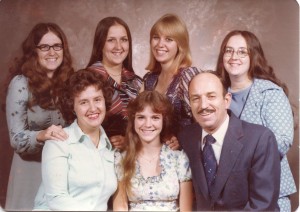 My sister, Cheryl Masterson is one of the most honorable people I know. She lives her life on purpose…following the will of God, and being a blessing to everyone she comes in contact with. Cheryl doesn’t just live a respectable life out in public, but lives that same respectable kind of life in private. She is a prayer warrior and is willing to pray without ceasing when needed. If you find yourself in a bad situation, Cheryl is definitely one of the people you want to have praying for you.
My sister, Cheryl Masterson is one of the most honorable people I know. She lives her life on purpose…following the will of God, and being a blessing to everyone she comes in contact with. Cheryl doesn’t just live a respectable life out in public, but lives that same respectable kind of life in private. She is a prayer warrior and is willing to pray without ceasing when needed. If you find yourself in a bad situation, Cheryl is definitely one of the people you want to have praying for you.
Cheryl is a family-first kind of person. Her children, grandchildren, great grandchildren, as well as sisters and  their families are her priority, second only to God. Her favorite things to do revolve around her kids and grandkids. She loves having family dinners, where all of her family come to eat and spend time together. Traditionally, Cheryl has a day or two a week when she cooks a big meal and her family all join her for dinner. Cheryl lives in our family home. During the last years of our parents lives, she was the live-in caregiver to them, while the rest of us put in time during the day. After our dad, Al Spencer’s passing, our mom, Collene Spencer made out her will, giving the house to her daughters, with a lifetime estate to Cheryl. The rest of us had homes, and it is a fitting reward for all the time Cheryl gave to their care. Now that our parents are both in Heaven, Cheryl no longer has patients to care for, freeing her up to entertain her family. She spends a lot of time with her youngest grandchild, Aleesia Spethman. They are very close and they enjoy their time together very much.
their families are her priority, second only to God. Her favorite things to do revolve around her kids and grandkids. She loves having family dinners, where all of her family come to eat and spend time together. Traditionally, Cheryl has a day or two a week when she cooks a big meal and her family all join her for dinner. Cheryl lives in our family home. During the last years of our parents lives, she was the live-in caregiver to them, while the rest of us put in time during the day. After our dad, Al Spencer’s passing, our mom, Collene Spencer made out her will, giving the house to her daughters, with a lifetime estate to Cheryl. The rest of us had homes, and it is a fitting reward for all the time Cheryl gave to their care. Now that our parents are both in Heaven, Cheryl no longer has patients to care for, freeing her up to entertain her family. She spends a lot of time with her youngest grandchild, Aleesia Spethman. They are very close and they enjoy their time together very much.
Cheryl is also artistically inclined, and has made many things for our homes. I still use one of basket decorations she made for me when my husband and I bought our home in 1995. I love it, and it brightens my breakfast nook. I don’t tend to be as artistically inclined, so when we bought our house, Cheryl was a huge help in it’s decoration. We had been living in a smaller mobile home, so there were a lot of walls to decorate in the 
 new house. It was a little overwhelming for me, but she made it seem easy. My other sisters, Caryl Reed, Alena Stevens, and Allyn Hadlock, as well as my parents helped too, and in the end, I loved the look. I have been very blessed to have the sisters I do, and Cheryl, being the eldest has always been the leader, and in many ways, now the spiritual leader of the Sister Prayer Warriors. Today is Cheryl’s birthday. Happy birthday Cheryl!! Have a great day!! We love you!!
new house. It was a little overwhelming for me, but she made it seem easy. My other sisters, Caryl Reed, Alena Stevens, and Allyn Hadlock, as well as my parents helped too, and in the end, I loved the look. I have been very blessed to have the sisters I do, and Cheryl, being the eldest has always been the leader, and in many ways, now the spiritual leader of the Sister Prayer Warriors. Today is Cheryl’s birthday. Happy birthday Cheryl!! Have a great day!! We love you!!
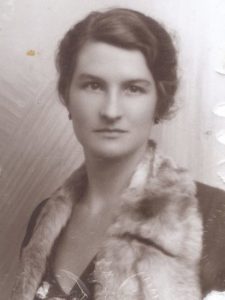
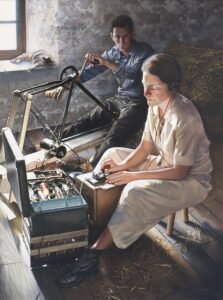 During World War II, the Allies used a number of spies, many of them women, but none of them could compare to Virginia Hall, who was considered by the Nazis to be the “most dangerous of all Allied spies.” I can’t think of a greater honor for a spy. It seems to me that the women spies were really the best spies of the war. Maybe it was because they just didn’t expect the women to be spies. That was a big advantage. Virginia Hall had one other thing that made it seem impossible to think of her as a spy…a prosthetic leg, which created a bit of a limp. It was the leg that earned Hall her other name…Limping Lady.
During World War II, the Allies used a number of spies, many of them women, but none of them could compare to Virginia Hall, who was considered by the Nazis to be the “most dangerous of all Allied spies.” I can’t think of a greater honor for a spy. It seems to me that the women spies were really the best spies of the war. Maybe it was because they just didn’t expect the women to be spies. That was a big advantage. Virginia Hall had one other thing that made it seem impossible to think of her as a spy…a prosthetic leg, which created a bit of a limp. It was the leg that earned Hall her other name…Limping Lady.
Born to wealthy parents in Baltimore, Maryland in 1906, Hall was expected to marry well, and become a wife and mother, but she had other plans. Describing herself as “cantankerous and capricious, Hall set her sights on being a diplomat after studying in Paris and falling in love with France, but out of 1500 US diplomats, only 6 were women, and Hall was turned down several times. Still hoping, she took a job as a clerical worker and the US Embassy in Warsaw, Poland. Then tragically, a hunting accident on a trip to Turkey, followed by gangrene infecting the leg, caused it to require amputation, which also disqualified her from the US Foreign Service. It was a crushing blow. She decided to resign from her job and move to Paris in 1939, just as World War II was erupting.
Hall’s life took a dramatic turn on May 10, 1940, when Germany invaded France. Volunteering to drive ambulances for the French army during the six-week long Battle of France, Hall transported wounded soldiers from the front line, while dodging fire from German fighter planes overhead. With the French surrender, Hall traveled to London to support the British war effort there. As she traveled, she impressed an undercover agent who put her in touch with a senior officer in the Special Operations Executive (SOE), which was Winston Churchill’s new secret service. Female operatives were not employed By the SOE, but after six months of failing to infiltrate a single new agent into France, they decided to send Hall to France as the SOE’s first female agent in the country. In the end, she would spend nearly the entire war in France, first as a spy for Britain’s SOE and later for the US Office of Strategic Services (OSS) Special Operations Branch.
Hall had a bit of a sense of humor, especially when it came to her heavy wooden leg, even nicknaming it Cuthbert. The leg was no obstacle to Hall’s courage either, nor her determination to defeat the Nazis, whom she bitterly hated. Hall used everything at her disposal while undercover in France, and proved herself “exceptionally adept at eluding the Gestapo as she organized resistance groups, masterminded jailbreaks for captured agents, mapped drop zones, reported on German troop movements, set up safe houses, and rescued escaped POWs and downed Allied pilots.” Like many veterans of that era, Even years after the war, Hall rarely talked about her extraordinary career. She attributes the habit to her years as a spy. She once said, “Many of my friends were killed for talking too much.”
Spy networks were amazingly able to hide in plane site, and when Hall arrived in the Vichy region of France in August 1941, it was under the cover story of being a war correspondent for the New York Post newspaper. Following her arrival in Toulouse, Hall established a resistance network called HECKLER, which gathered information about German troop movements and helped downed British pilots escape to safety. Following her work in Toulouse, she traveled to Lyon, where she helped coordinate activities of the French Resistance. Her plans changed when the United States entered the war. As a US citizen, she could be considered a traitor for working for the British spy networks, because the United States had been considered neutral. Hall was forced underground, but continued operating in France for another 14 months. A good spy needs to have a variety of disguises at the disposal, and Hall became adept at changing her appearance on a moment’s notice. She was also known by multiple aliases. She needed to be almost invisible, at least to the enemy. The Germans, at least early in the war, didn’t think that a woman was capable of being a spy. What a serious miscalculation that turned out to be!!
Hall’s extraordinary effectiveness amazed the SOE commanders and helped change their minds about women operating in combat zones. A year after Hall began working undercover, the SOE finally decided to send more female agents into the field. Hall’s abilities paved the way for more women to serve their countries in this important capacity. It also quickly put women spies, and Hall specifically, on the radar for the Gestapo. Soon, the hunt for “the Limping Lady” was on. They knew only her from a composite sketch, which was to her advantage. Their internal communications declared: “She is the most dangerous of all Allied spies. We must find and destroy her.” Gestapo agents…including notorious investigator Klaus Barbie, who would later be awarded the Iron Cross for torturing and executing thousands of resisters…closing in on her after the Germans seized control of Vichy France in November 1942, Hall was forced to escape to Spain.
To escape France was no easy task. It meant a three day journey on foot in heavy snow across the Pyrenees mountains. The trek was made even more challenging with an 8-pound artificial leg bound to her body with straps and a belt at the waist. At one point, she jokingly mentioned in a message to the SOE that she was concerned that “Cuthbert” would cause problems during her escape. In a funny twist, the receiver of the message didn’t recognize the nickname she used for her prosthetic. SOE headquarters responded, “If Cuthbert is giving you difficulty, have him eliminated.” In the end, it wasn’t “Cuthbert” that caused her problems. When she arrived in Spain, she was arrested and imprisoned for illegally entering the country. Hall was an inmate for six weeks before an inmate being released was able to get word to American officials in Barcelona about her presence so they could arrange her release. She finally made it back to London in January 1943, where she was quietly made a honorary Member of the Order of the British Empire.
Following her imprisonment, the SOE refused to send her back to France, because they thought was too dangerous with her high profile. That decision was unacceptable to Hall, who decided to join the American Office of Strategic Services (OSS), which was just establishing their own intelligence operation in France. The Nazi troops were everywhere by that time, so Hall took even more extreme measures to disguise herself. Among them, a French milkmaid, causing her to need to have a rather scary dentist grind down her lovely, white American teeth. In the Haute-Loire region of central France, she disguised herself as an elderly milkmaid and got to work on her radio, coordinating airdrops of arms and supplies for the resistance fighters who were blowing up bridges and sabotaging troop trains, and reporting German troop movements to Allied forces.
Her second tour in France in 1944 and 1945 was even more successful than her first, and at its peak, her network consisted of 1,500 people. With the Germans constantly attempting to track her radio signals, Hall stayed on the move, camping out in barns and attics. As D-Day approached, Hall was operating as a guerrilla leader, and she armed and trained three battalions of French resistance fighters for sabotage missions that helped paved the way for the Allied invasion. One of her many radio reports shows the breadth of her missions. She stated that her team had destroyed four bridges, derailed freight trains, severed a key rail line, and downed telephone lines. By the war’s end, Hall had spent over three full years operating undercover behind enemy lines and, in the words of an official British government report at the end of the war, she was “amazingly successful.”
After the war, when the OSS was dissolved, it became the Central Intelligence Agency (CIA), Hall became an intelligence analyst. For her wartime service, she was awarded the Croix de Guerre with Palme by France and became the only civilian woman during WWII to be awarded a Distinguished Service Cross by the US, which recognizes exceptional valor and risk of life in combat. President Harry Truman wanted to have a public ceremony for the presentation of the medal, but Hall requested a private ceremony instead, saying that she was “still operational and most anxious to get busy.” Hall worked at the CIA until she retired in 1966 and took 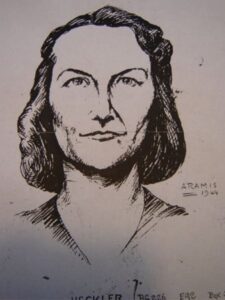
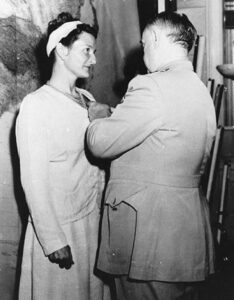 quiet pride in her service to her country, although she always maintained a wry sense of humor about it. Her response to receiving the Distinguished Service Cross was, “Not bad for a girl from Baltimore.”
quiet pride in her service to her country, although she always maintained a wry sense of humor about it. Her response to receiving the Distinguished Service Cross was, “Not bad for a girl from Baltimore.”
While in Haute-Loire, Hall had met and fallen in love with an OSS lieutenant, Paul Goillot, who worked for her. In 1957, the couple married after living together off-and-on for years. Hall went on to head the CIA. The other four heads were men. Hall was code named Marie and Diane, but the Germans gave her the nickname Artemis, and the Gestapo reportedly considered her “the most dangerous of all Allied spies.” Because of her artificial foot, she was also known as “the limping lady.” She died on July 8, 1982 at the age of 76 in Barnesville, Maryland.

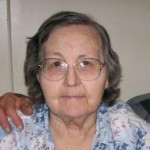 When my moms passed away, my mom, Collene Spencer in 2015 and my mother-in-law, Joann Schulenberg in 2018, Mother’s Day was forever changed for me. I no longer had a mom on this earth. It was a lonely feeling, because they were both so very special. I couldn’t have asked for better moms in my life. They were somewhat different from each other, but they both had very special qualities, and each had special gifts. Both of my moms were excellent cooks, but they made different specialties. My sister, Cheryl Masterson found some cute questionnaires of memories to put together with her grandchildren, and one of the questions concerned the favorite food their mother made. That got me thinking about my moms, and the foods they made. Probably my favorite of my mom’s meals, was Tuna Casserole. I know that may sound odd, but it was amazing, and for some odd reason, I can’t make it taste like hers did, recipe or not. I don’t know what she did, but my guess is that it was made with love. My mother-in-law made an unusual dish, that I would never have guessed that I would love, but when my husband begged me to eat it with an open mind (we were dating at the time), I thought my goose was cooked. Her dish was Squash and Pancakes. Now you can wrinkle your nose all you want, but it is amazing, and I love it. The memories you have are a sweet thing when your loved one is in Heaven and you can’t see them anymore.
When my moms passed away, my mom, Collene Spencer in 2015 and my mother-in-law, Joann Schulenberg in 2018, Mother’s Day was forever changed for me. I no longer had a mom on this earth. It was a lonely feeling, because they were both so very special. I couldn’t have asked for better moms in my life. They were somewhat different from each other, but they both had very special qualities, and each had special gifts. Both of my moms were excellent cooks, but they made different specialties. My sister, Cheryl Masterson found some cute questionnaires of memories to put together with her grandchildren, and one of the questions concerned the favorite food their mother made. That got me thinking about my moms, and the foods they made. Probably my favorite of my mom’s meals, was Tuna Casserole. I know that may sound odd, but it was amazing, and for some odd reason, I can’t make it taste like hers did, recipe or not. I don’t know what she did, but my guess is that it was made with love. My mother-in-law made an unusual dish, that I would never have guessed that I would love, but when my husband begged me to eat it with an open mind (we were dating at the time), I thought my goose was cooked. Her dish was Squash and Pancakes. Now you can wrinkle your nose all you want, but it is amazing, and I love it. The memories you have are a sweet thing when your loved one is in Heaven and you can’t see them anymore.
My idea of Mother’s Day had to turn toward, of course, being mom to my girls, Corrie Petersen and Amy Royce, but also to them being mothers, Corrie to Chris (fiancée Karen) and Josh (girlfriend Athena), and Amy to Shai and Caalab (girlfriend Chloe), all of whom I consider my own. Mother’s Day also turned to Chris’ fiancée, Karen, who is mom to Cambree and Caysen, my precious great grandbabies. Half of my family lives in Washington, and half in Wyoming. That has made our holidays different too. Nevertheless, we love each and every one of them, and they love us. I am a very blessed mom. I also thought of the moms in my family, my sisters, Cheryl 
 Masterson, Caryl Reed, Alena Stevens, and Allyn Hadlock; my sisters-in-law, Debbie Cook and Jennifer Parmely, as well as my late sister-in-law, Rachel Schulenberg. I thought of their daughters and granddaughters with children, and realized that while my moms are in Heaven now, the tradition continues. I cant name or picture them all, but they are all great moms. Moms will always be with us, either in life or in our hearts. Mother’s Days will change as time marches on, but we will always have those moms. Nothing can take that from us. Happy Mother’s Day to all the moms. Have a blessed day!!
Masterson, Caryl Reed, Alena Stevens, and Allyn Hadlock; my sisters-in-law, Debbie Cook and Jennifer Parmely, as well as my late sister-in-law, Rachel Schulenberg. I thought of their daughters and granddaughters with children, and realized that while my moms are in Heaven now, the tradition continues. I cant name or picture them all, but they are all great moms. Moms will always be with us, either in life or in our hearts. Mother’s Days will change as time marches on, but we will always have those moms. Nothing can take that from us. Happy Mother’s Day to all the moms. Have a blessed day!!
 My grand-niece, Maeve Parmely is a child of the Covid lockdowns, and the secondary phenomenon, Stranger Danger. As a two year old girl, Maeve’s time was suddenly spent all pretty much with her immediate family, and maybe sometimes grandparents, so she didn’t know many other people very well…including aunts, uncles, and cousins. Now that families can gather together again, Maeve’s parents, Eric and Ashley Parmely suggested monthly family dinners, with the purpose of letting the children get reacquainted with family. For Maeve’s older siblings, Reagan, Hattie, and Bowen getting to know family was easy, but for Maeve, it was a little more difficult. She is a little more shy and reserved. She will come around, of course, and when her uncle, Bob Schulenberg brings chips to the party, it really helps break the ice. Those chips were an ice breaker for everyone, even if we did eat before dinner, and they certainly didn’t ruin anyone’s appetite either.
My grand-niece, Maeve Parmely is a child of the Covid lockdowns, and the secondary phenomenon, Stranger Danger. As a two year old girl, Maeve’s time was suddenly spent all pretty much with her immediate family, and maybe sometimes grandparents, so she didn’t know many other people very well…including aunts, uncles, and cousins. Now that families can gather together again, Maeve’s parents, Eric and Ashley Parmely suggested monthly family dinners, with the purpose of letting the children get reacquainted with family. For Maeve’s older siblings, Reagan, Hattie, and Bowen getting to know family was easy, but for Maeve, it was a little more difficult. She is a little more shy and reserved. She will come around, of course, and when her uncle, Bob Schulenberg brings chips to the party, it really helps break the ice. Those chips were an ice breaker for everyone, even if we did eat before dinner, and they certainly didn’t ruin anyone’s appetite either.
Maeve has lived on a farm all her life. She loves the animals. On day when we were out  there, Maeve went out exploring, or just to get some quiet time, and ended up toward the front of the property, with three cows. Maeve was not afraid of them, nor they of her. They are actually all very comfortable together, and the cows somehow understand that Maeve is little, and they need to be careful, but that in reality, Maeve is absolutely the boss. In fact, Maeve’s great aunt, Nancy Eighmy calls her the cow whisperer, and I would have to agree. They just like to be near this precious little girl. And it’s not just the cows that Maeve loves to be around. The family has new kittens right now, and They are very much the rage. There are also the horses, baby goats, turkeys, chickens, and pigs. That means there is lots of entertainment. She also loves the mountains and snow, especially if somebody carries her. Still, she loves being in the snow.
there, Maeve went out exploring, or just to get some quiet time, and ended up toward the front of the property, with three cows. Maeve was not afraid of them, nor they of her. They are actually all very comfortable together, and the cows somehow understand that Maeve is little, and they need to be careful, but that in reality, Maeve is absolutely the boss. In fact, Maeve’s great aunt, Nancy Eighmy calls her the cow whisperer, and I would have to agree. They just like to be near this precious little girl. And it’s not just the cows that Maeve loves to be around. The family has new kittens right now, and They are very much the rage. There are also the horses, baby goats, turkeys, chickens, and pigs. That means there is lots of entertainment. She also loves the mountains and snow, especially if somebody carries her. Still, she loves being in the snow.
Maeve is very resourceful. If she wants something, she knows how to get it for herself. She can climb, and  reach, and if that doesn’t work, she will resort to getting her older siblings to get her what she wants. Hmmmm…she might be a sibling whisperer too. Maeve doesn’t talk too often, although she certainly can. It’s just that her siblings usually see to her every need, often before she even asks for things. I guess that just comes from being the baby of the family. Maeve is well cared for, and maybe a little bit babied, but she is just so darned cute that you just have to forgive her family for spoiling her a little. And besides, she doesn’t seem to be very spoiled at all. Today is Maeve’s 2nd birthday, and she gets to share her day with her moms Mothers Day, which is very special too. Happy birthday sweet Maeve. Have a great day!! We love you!!
reach, and if that doesn’t work, she will resort to getting her older siblings to get her what she wants. Hmmmm…she might be a sibling whisperer too. Maeve doesn’t talk too often, although she certainly can. It’s just that her siblings usually see to her every need, often before she even asks for things. I guess that just comes from being the baby of the family. Maeve is well cared for, and maybe a little bit babied, but she is just so darned cute that you just have to forgive her family for spoiling her a little. And besides, she doesn’t seem to be very spoiled at all. Today is Maeve’s 2nd birthday, and she gets to share her day with her moms Mothers Day, which is very special too. Happy birthday sweet Maeve. Have a great day!! We love you!!
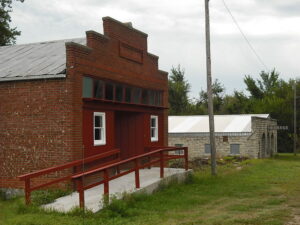 The “almost” ghost town of Bushong, Kansas got its start in 1886 when the Missouri Pacific Railroad built its tracks across Northern Lyon County. The railroad station was named Weeks, as was the town at first, after Joseph Weeks, who donated 20 acres of land to the railroad. After the railroad built on part of the acreage, it sold some of the acreage as town lots. Although there was no town company, per se, Joseph Weeks also platted another 20 acres and sold lots on that, and a town was born. The Missouri Pacific Railroad also built a large tank pond one mile east of town to supply the steam engines with water, as they pulled their trains over the hills to Council Grove. There were large pastures filled with cattle in the area, and cattle pens were constructed to hold the cattle for shipping. The railroad also bought a valuable stone quarry south of Bushong and shipped quarried rock to Kansas City, about an hour and a half to their Northeast.
The “almost” ghost town of Bushong, Kansas got its start in 1886 when the Missouri Pacific Railroad built its tracks across Northern Lyon County. The railroad station was named Weeks, as was the town at first, after Joseph Weeks, who donated 20 acres of land to the railroad. After the railroad built on part of the acreage, it sold some of the acreage as town lots. Although there was no town company, per se, Joseph Weeks also platted another 20 acres and sold lots on that, and a town was born. The Missouri Pacific Railroad also built a large tank pond one mile east of town to supply the steam engines with water, as they pulled their trains over the hills to Council Grove. There were large pastures filled with cattle in the area, and cattle pens were constructed to hold the cattle for shipping. The railroad also bought a valuable stone quarry south of Bushong and shipped quarried rock to Kansas City, about an hour and a half to their Northeast.
As the town grew, more buildings were needed. The first school building was erected in 1886. The school was a two-story wood-frame structure, and it housed grades 1-8. The school was used until 1948. Then, students were moved to the brick high school building, and the old school building was sold and removed. When the new settlement gained a post office on January 31, 1887, the name was changed to Bushong in honor of Al “Doc” Bushong, who was a baseball player for the Saint Louis Browns. The player’s greatest success came when he was the starting catcher in the 1886 World Series. The Saint Louis Browns of the American Association beat the Chicago White Stockings of the National League. The team owner wanted to do something special for his team to mark their success. Somehow, he made the arrangements for each player to have a town named after them. While all the players had towns named after them, Bushong is the only town that still carries the name of the player they were to have honored. In 1887, Bushong had a population of about 75 people. The first station agent was R D Cottrell, who also built the Bushong Hotel, which he operated with his wife until his death, then she remarried and continued to operate the hotel for a few more years. Other early businesses included a general store, a flour mill, blacksmith, lumber yard, boarding house, and a hog fence factory.
In the town’s saddest event, twelve members of the population died within 48 hours of each other in February 1894, when a diphtheria epidemic gripped the town. It was the last great pandemic of the 19th century, and among the deadliest pandemics in history. The worst effects of the pandemic took place from October 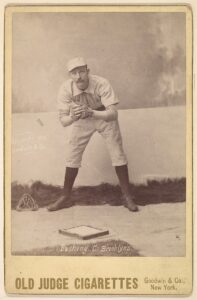 1889 to December 1890, with recurrences in March to June 1891, November 1891 to June 1892, winter of 1893–1894, and early 1895. At the same time, the school in Bushong was closed. The towns first and only doctor, Chester L Stocks, set up his practice in 1896. He was also a druggist, and he continued to serve the community until 1934.
1889 to December 1890, with recurrences in March to June 1891, November 1891 to June 1892, winter of 1893–1894, and early 1895. At the same time, the school in Bushong was closed. The towns first and only doctor, Chester L Stocks, set up his practice in 1896. He was also a druggist, and he continued to serve the community until 1934.
For a brief time in 1899, the town boasted a newspaper called the Bushong Bulletin. It was a small town, and really, how much news could there be. A Methodist church was established that year. It had one large room with a pot-bellied stove in the center and an organ. By 1910, Bushong was a thriving town with a population of 250. The post office even had one rural route. The town also had a number of general stores, a hotel, public school, telegraph, telephone, and express service, and its railroad was providing a considerable amount of shipping. For many years trains stopped at Bushong for passengers. When passenger service was discontinued, trains could still be stopped by “flagging” them down to load freight or livestock. It finally became necessary to establish the Bushong Rural High School, and classes were held in the upper room of the grade school in 1913. Later, students were taught in other town buildings, with the first graduation taking place in 1916. The town also became home to The Bushong State Bank, which was chartered in 1916, but like many other banks, it failed during the Great Depression and closed in 1932. A new brick High School was erected in 1918 consisting of four rooms. Later additions were made, including a gymnasium in 1926. Unfortunately, a fire in the 1920s destroyed a large portion of the downtown area, and the buildings were never rebuilt. In 1923 a new Methodist church building was erected on the same site as the first one. The building utilized the bell from the old church in the belfry. That year, the town’s population was 150. However, the next year, severe drought and heat caused many settlers to move from the area. Bushong was incorporated in 1927, and L A Grimsley was elected as the first mayor. At that time, the town had a population of about 150 and continued to maintain its two room grade school and a four-room rural high school. The Methodist Church and Sunday School were well attended. At about that same time, electricity was approved, and in 1936 Bushong voted to sell their utility to Kansas Electric Company of Emporia. Bushong’s early telephone system was part of the Farmers Mutual Telephone Association, a cooperative company that everyone helped to construct and care for lines and poles. The telephone company was sold in 1960. Like numerous other communities, Bushong was hit hard by the Great Depression and never recovered.
In 1955, school enrollment had dropped to such a degree that Bushong consolidated with the other area schools. High school pupils went to nearby Allen until Northern Heights opened in the fall of 1957, consolidating the high schools of Bushong, Allen, Admire, and Miller. Grade school continued at Bushong until 1966 when all area 3rd and 4th graders went to Bushong and the other grades to Allen and Admire. The school finally closed  in 1970, and the city purchased the building for use as a Civic Center. Currently, the building is abandoned. The railroad discontinued the depot in 1957, and later the depot building was torn down.
in 1970, and the city purchased the building for use as a Civic Center. Currently, the building is abandoned. The railroad discontinued the depot in 1957, and later the depot building was torn down.
During the Cold War, Bushong was again in the spotlight. I became the location of one of the first generations of nuclear-tipped intercontinental ballistic missiles. One of several Atlas class missile silos developed in the Midwest, active from 1961-1965, was part of the 548th Strategic Missile Squadron was located in the small town. Unfortunately, that was still not enough to save the town from virtual extinction. Bushong’s post office closed on July 2, 1976. Today, Bushong is called home to only about 30 people with no open businesses. The old community is located about 20 miles northwest of Emporia. It’s strange how things work out. What starts out as a thriving town, sometimes gives way to a ghost town, while other times, the town grows to greatness.
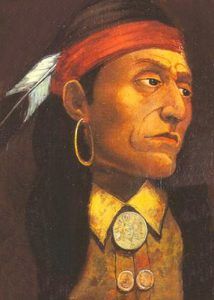 The pilgrims were not the only people who did not like, or accept, British rule. When the French sold some of their territory to the British, the Indian tribes in these areas were not happy about the new regime. The French had more or less left them alone to do as they chose, and so they tended to live in relative peace, but the British were a different kind of rule, and the Indians felt that they were far less conciliatory than their predecessors. It wasn’t that the French and the Indians got along well, after all they had just ended the French and Indian Wars in the early 1760s. It was simply that the British were more demanding and less giving in the area of the Indian rights, than the French had been.
The pilgrims were not the only people who did not like, or accept, British rule. When the French sold some of their territory to the British, the Indian tribes in these areas were not happy about the new regime. The French had more or less left them alone to do as they chose, and so they tended to live in relative peace, but the British were a different kind of rule, and the Indians felt that they were far less conciliatory than their predecessors. It wasn’t that the French and the Indians got along well, after all they had just ended the French and Indian Wars in the early 1760s. It was simply that the British were more demanding and less giving in the area of the Indian rights, than the French had been.
As the matter became more and more heated, an Ottawan Indian chief named Pontiac decided that it was time for the Indian tribes to rebel. So, he called together a confederacy of Native warriors to attack the British force at Detroit. In 1762, Pontiac enlisted support from practically every tribe from Lake Superior to the lower Mississippi for a joint campaign to expel the British from the formerly French-occupied lands. According to Pontiac’s plan, each tribe would seize the nearest fort and then join forces to wipe out the undefended settlements. In April 1763, Pontiac convened a war council on the banks of the Ecorse River near Detroit. It was decided that Pontiac and his warriors would gain access to the British fort at Detroit under the pretense of negotiating a peace treaty, giving them an opportunity to seize forcibly the arsenal there. However, British Major Henry Gladwin learned of the plot, and the British were ready when Pontiac arrived in early May 1763, and Pontiac was forced to begin a siege. His Indian allies in Pennsylvania began a siege of Fort Pitt, while other sympathetic tribes, such as the Delaware, the Shawnees, and the Seneca, prepared to move against various British forts and outposts in Michigan, New York, Pennsylvania, Maryland and Virginia, at the same time. After failing to take the fort in their initial assault, Pontiac’s forces, made up of Ottawas and reinforced by Wyandots, Ojibwas and Potawatamis, initiated a siege that would stretch into months.
A British relief expedition attacked Pontiac’s camp on July 31, 1763. They suffered heavy losses and were repelled in the Battle of Bloody Run. However, they did succeeded in providing the fort at Detroit with reinforcements and supplies. That victorious battle allowed the fort to hold out against the Indians into the fall. Also holding on were the major forts at Pitt and Niagara, but the united tribes captured eight other fortified posts. At these forts, the garrisons were wiped out, relief expeditions were repulsed, and nearby frontier settlements were destroyed.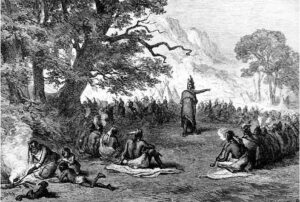
Two British armies were sent out in the spring of 1764. One was sent into Pennsylvania and Ohio under Colonel Bouquet, and the other to the Great Lakes under Colonel John Bradstreet. Bouquet’s campaign met with success, and the Delawares and the Shawnees were forced to sue for peace, breaking Pontiac’s alliance. Failing to persuade tribes in the West to join his rebellion, and lacking the hoped-for support from the French, Pontiac finally signed a treaty with the British in 1766. In 1769, he was murdered by a Peoria tribesman while visiting Illinois. His death led to bitter warfare among the tribes, and the Peorias were nearly wiped out.

